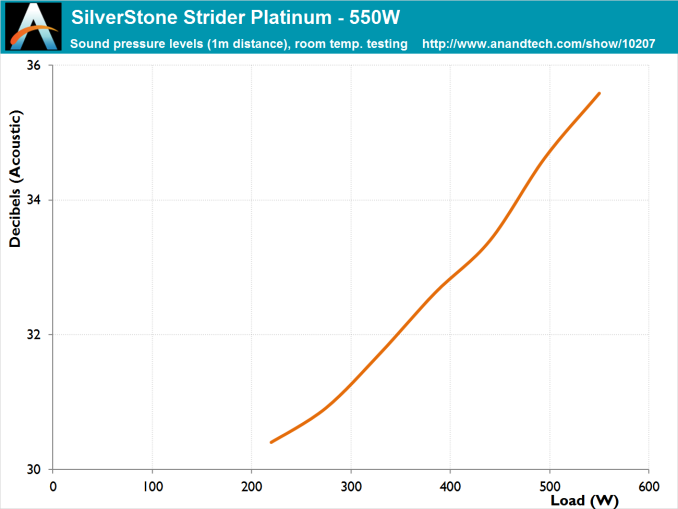The SilverStone Strider Platinum 550W PSU Review
by E. Fylladitakis on April 8, 2016 8:00 AM EST- Posted in
- PSUs
- Cases/Cooling/PSUs
- 550W
- SilverStone
- 80Plus Platinum
Cold Test Results
For the testing of PSUs, we are using high precision electronic loads with a maximum power draw of 2700 Watts, a Rigol DS5042M 40 MHz oscilloscope, an Extech 380803 power analyzer, two high precision UNI-T UT-325 digital thermometers, an Extech HD600 SPL meter, a self-designed hotbox and various other bits and parts. For a thorough explanation of our testing methodology and more details on our equipment, please refer to our How We Test PSUs - 2014 Pipeline post.
The conversion efficiency of the Strider Platinum 550W at room temperature is good, although it technically missed the 80Plus Platinum certification limits during our testing. For 80Plus Platinum units under 230VAC input, the directive dictates that the unit should have an efficiency of at least 92% under 20% load and our instrumentation ended up recording 91.6% at that point. The actual difference is small and can be even attributed to the slightly higher ambient temperature of our testing environment (room temperature is defined as 25 °C and that is used for 80Plus certification tests, while our room temperature was nearly 27 °C at the time of our testing). The average efficiency is 92.4% within the nominal load range (20% to 100% of the unit's capacity) and reaches up to 94.1% at 50% load, just above the 80Plus Platinum certification mark. It is also worthwhile to mention that the Strider Platinum displayed some of the best low load efficiency figures that we have seen to this date.
As this is a semi-fanless (zero fan speed idle) design, the fan is programmed not to start until it is necessary for the cooling needs of the unit. During our testing in room temperature, the fan started right before the load reached 220 Watts, 40% of the unit’s maximum capacity. After that point, the fan started and continued to increase its speed alongside with the load, but barely reached up to 60% of its maximum speed at full load, generating just above 36 dB(A). Due to the relatively high efficiency of the PSU, the Strider Platinum held low operating temperatures during our room temperature testing, barely reaching above 55 °C.















27 Comments
View All Comments
tarqsharq - Friday, April 8, 2016 - link
First sentence of the Final Words section broke.revanchrist - Friday, April 8, 2016 - link
SilverStone ST60F-TI is even more mind blowing. 600W Titanium and very compact in size. Also fully modular.JoeyJoJo123 - Friday, April 8, 2016 - link
Titanium rated power supplies would be a lot more appealing if you lived in a region that used 230V for the main electric line. North America uses 115V and any Titanium rated PSU would function (at best) at Platinum level efficiency there.Daniel Egger - Friday, April 8, 2016 - link
Not sure where you got your information from but this seems to be incorrect according to a quick check with Wikipedia.JoeyJoJo123 - Friday, April 8, 2016 - link
http://www.techpowerup.com/forums/threads/super-fl..."80 Plus Titanium is where it's at. Applicable only in regions with 220~230VAC domestic power, 80 Plus Titanium requires a PSU to offer at least 94 percent efficiency at 20 percent load, at least 96 percent efficiency at 50 percent load, and at least 91 percent efficiency at 100 percent load."
The way I read it is that 80+ Titanium efficiency only worked in households supporting 230V lines, however, if you're at 115V, you wouldn't get the full 80+ Titanium efficiency you'd probably be at around 80+ Platinum efficiency rating.
Also note that the efficiency requirements are different for regions with different main electric supplies. North America, Brazil, Japan, etc has lower requirements to hit the same efficiency benchmarks (Bronze, Silver, etc) than 230V countries.
Daniel Egger - Friday, April 8, 2016 - link
How about you check with some authoritative source? I get you don't trust Wikipedia, how about the official homepage? http://www.plugloadsolutions.com/80PlusPowerSuppli...The only case where 80 Plus Titanium isn't defined is 115V industrial, which doesn't apply here. For any other case it is defined and a lot stricter than Platinum.
nevcairiel - Friday, April 8, 2016 - link
Fact remains that PSUs are generally more efficient when running at 230V, and the 80 Plus specification reflects that by lowering the limits on 115V.The comment about Titanium JoeyJoJo123 quoted probably applied to one particular PSU which was 230V Titanium but didn't quite reach it for 115V, which may be a bit harder to hit?
Daniel Egger - Saturday, April 9, 2016 - link
> Fact remains that PSUs are generally more efficient when running at 230V, and the 80 Plus specification reflects that by lowering the limits on 115V.True but besides the point. If a product is rated for "80 Plus Titanium" compliance it actually needs to comply with the requirements in each category and in each category Titanium has stricter demands than the Platinum tier. In other words: If you take a Titanium unit and operate it at 230V it needs to match the Titanium requirements for 230V, if you take the same unit to NA and operate it at 110V it still needs to comply with the Titanium requirements but the ones for 110V (which are a bit less strict than the 230V ones but still stricter than the Platinum tier at the same voltage).
Daniel Egger - Friday, April 8, 2016 - link
This is one very sexy PSU indeed. Thanks for bringing it to my attention...dreamcat4 - Saturday, April 9, 2016 - link
Hey Anandtech! The Silverstone SX700-LPT 700W Platinum SFX-L is finally due to become avavailable and start shipping this month / very soon. After unspecified teething / production issues has delayed production. Therefore now would be a very good time to review it.